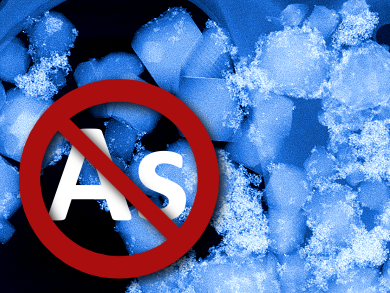Arsenic is very toxic, especially in the form of its As(III) species. A common approach to arsenic removal from water is adsorption with materials such as zeolites or activated carbon, due to their ease of use and low cost. The World Health Organization (WHO) recommends values of less than 10 μg/L of arsenic in drinking water. Achieving this standard can, however, be difficult. Iron oxide nanoparticles are promising adsorbents due to their high surface area and the possibility of recovering them with magnets. Unfortunately, their stabilty in aqueous solution is hampered by oxidation, reduction, and agglomeration.
To improve the stability of Fe3O4 nanoparticles, Pascal Van Der Voort, Ghent University, Belgium, and colleagues have loaded them onto the chromium-based metal-organic framework (MOF) MIL-101(Cr). The iron oxide particles were synthesized in situ by preparing a suspension of FeCl2, FeCl3, and the MOF, to which an ammonia solution was added. The hybrid material (Fe3O4@MIL-101) was characterized by powder XRD (XRPD) analysis, annular dark-field scanning transmission electron microscopy (ADF-STEM) imaging and energy-dispersive X-ray (EDX) mapping. The MOF formed crystals with sizes between 200 and 300 nm and the majority of Fe3O4 nanoparticles was found on the crystal surface.
The researchers tested the material’s effciency for arsenic removal by immersing it in solutions of NaAsO2 and Na2HAsO4. It performed better than both the MOF alone and the pure iron oxide nanoparticles. Fe3O4@MIL-101 achieved removal efficiencies of 94.7 % and 99.9 % for the As(III) and As(V) species, respectively. According to the team, the high efficiencies were retained with real ground and surface water samples, showing the potential of the approach for practical application.
- Fe3O4@MIL-101 – A Selective and Regenerable Adsorbent for the Removal of As Species from Water,
Karel Folens, Karen Leus, Nina Ricci Nicomel, Maria Meledina, Stuart Turner, Gustaaf Van Tendeloo, Gijs Du Laing, Pascal Van Der Voort,
Eur. J. Inorg. Chem. 2016.
DOI: 10.1002/ejic.201600160




